
NPS / Brad Sutton While exploring Joshua Tree National Park, you may end up scrambling over large rocks, boulder piles, and granite monoliths. Scrambling combines elements of hiking and climbing, allowing adventurers to traverse rugged terrain. 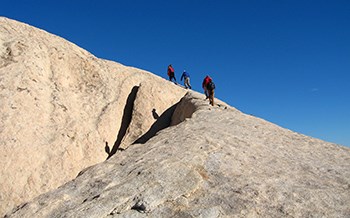
NPS / Robb Hannawacker What is Scrambling?Scrambling involves moving over 2nd-, 3rd-, and 4th-class rocky terrain. For comparison, hiking is usually over 1st- and 2nd-class terrain and rock climbing often requires a rope to ascend 5th-class terrain. Scramblers will frequently use their arms to hold onto and move over rock. Scrambling typically occurs off-trail and is common in Joshua Tree as the park has many large boulders and rock formations that can be fun to traverse. However, it's important to remember that this activity comes with inherent risks. Preparation is critical to ensure a safe and enjoyable experience. 
NPS / Hannah Schwalbe Where to ScrambleBe well-prepared before embarking on a scrambling adventure in Joshua Tree National Park. Start by researching the specific areas you plan to explore. Study maps, guidebooks, and online resources to familiarize yourself with the terrain and potential hazards. Be aware of the difficulty level and technical requirements of the routes you choose, and assess your abilities and experience. There are many popular scrambling locations in Joshua Tree. A few include: Quail Springs, Skull Rock, Hidden Valley Nature Trail, and Indian Cove Campground. Never move up rock that you can’t get down from. It is easier to go up than to come down. What to BringSturdy shoes with good traction are essential for navigating uneven surfaces and rocky terrain. Consider wearing approach shoes with a sticky rubber sole instead of hiking shoes. Wear comfortable clothing that allows freedom of movement and protects you from the sun and abrasive surfaces. A helmet can be helpful depending on the route. Carry a backpack with essentials such as water, snacks, a first aid kit, a map, and a compass. It's also wise to bring a whistle, a flashlight, and a GPS unit for emergencies. For more tips, check out the Safety page. Scramble SafetyWhile scrambling over rocks can be exhilarating, it's crucial to prioritize safety at all times. Here are some important safety messages to keep in mind:
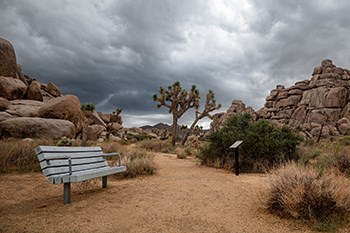
NPS Photo/ Carmen Aurrecoechea Classes of Terrain1st-Class: Generally flat and easily walkable terrain. Hikers can keep their weight on their feet at all times and won't need their arms to help move over the terrain. Class 1 terrain and trails may gain elevation and vary greatly in their difficulty level. They often require some hiking gear, including hiking shoes and occasionally hiking poles. Many of Joshua Tree's trails are 1st-class, including the Cap Rock Nature Trail and the Bajada Nature Trail. Learn more about these trails on the Hiking page. 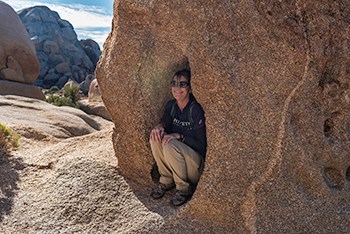
NPS / Emily Hassell 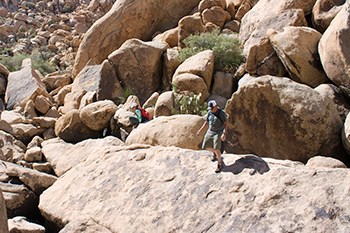
NPS / Hannah Schwalbe 3rd-Class: This terrain is often very rugged and requires more consistent use of one's hands to move. Joshua Tree has lots of 3rd-class terrain and is solid scrambling territory. Most people won't use ropes, but some may want a rope on this terrain for extra safety, especially if there is exposure or inexperienced scramblers. Scramblers moving over 3rd-class terrain should consider wearing a helmet. Hiking poles are not recommended for 3rd-class terrain in Joshua Tree as having free hands for balance and grabbing rock may be vital. Scrambling up to the top of one of the many rock formations in Joshua Tree is likely 3rd-class. Approach shoes with rubber soles may become necessary for safely moving over the park's 3rd-class, rocky terrain. 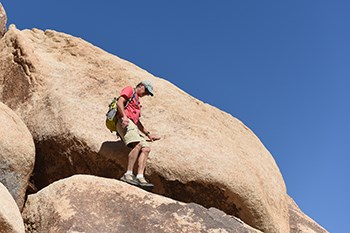
NPS / Hannah Schwalbe 4th-Class: 4th class requires considerable skill and some gear. It is often steep and can have significant exposure that could result in a fatality in the case of a fall. Some of the rocky, steep approaches to climbing routes are 4th-class in the park as are many walk-offs (a climbing term referring to the descent down a rock if there is no option to rappel). Wear rubber-soled approach shoes and a helmet for 4th-class terrain. Some scramblers and climbers use ropes to move over 4th class terrain, though ropes are less common than they are on 5th-class terrain. It is easy to move from 3rd-class to 4th-class terrain without realizing it until it's too late. Never move up terrain from which you cannot get down. 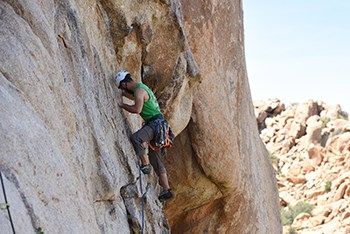
NPS / Hannah Schwalbe 5th-Class: This is rock climbing or bouldering terrain, and climbing or bouldering gear is required to ascend and descend safely. This rock is very steep and requires a certain skill level for climbers and boulders who break down and rate 5th-class terrain into specific categories. For climbers, those ratings range from 5.0 (the easiest of the 5th-class terrain) to 5.14 or even 5.15 (the most challenging 5th-class terrain). Boulderers use a similar system from V0-V16. Hire a local climbing guide if you are not an experienced climber but would like to explore the park's 5th-class terrain. |
Last updated: January 15, 2025
